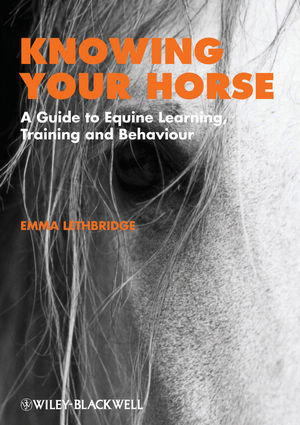Knowing Your Horse: A Guide to Equine Learning, Training and BehaviourISBN: 978-1-4051-9164-7
Paperback
208 pages
May 2009, Wiley-Blackwell
 This is a Print-on-Demand title. It will be printed specifically to fill your order. Please allow an additional 10-15 days delivery time. The book is not returnable.
|
||||||
Dedication
Acknowledgements
Introduction
Chapter 1 The Principles of Good Horse Training
Ten Basic Principles of Good Horsemanship
Learning recap
Chapter 2 Does Classical Conditioning Ring a Bell?
Different Stimuli and Response Terms
Training Task: How to Classically Condition Your Horse
Specific Training Situations
Learning recap
My training log
Chapter 3 Living With the Consequences
Operant Conditioning
Applying Simple Operant Conditioning
Training Task: ‘Don’t Mug Me’ Training
Learning recap
My training log
Chapter 4 All Possible Consequences
Defining Positive and Negative Consequences
Reinforcement
Punishment
Which Consequence?
Learning recap
Chapter 5 Other Laws and Factors in Learning
The Final Law – Extinction
Understanding Generalisation and Discrimination Learning in Training
Learning recap
Chapter 6 The Power of Positive Reinforcement
What Can Be a Positive Reinforcer?
Which Reinforcer Should I Use?
When to Reward
Training Using Positive Reinforcement
Learning recap
Training Task: Using Positive Reinforcement to Teach the Back, the Heel, the Stay, the Recall and the Yield
Training Task: Teaching the Head Down and Placement using the Target Lure
My training log
Chapter 7 The Sound of Learning – Clicker Training
What is Clicker Training?
The Training Game
Target Training
The Secrets of Clicker Success
Learning recap
Training Task: Using Clicker Training
My training log
Chapter 8 Negative Reinforcement – Reinforcement Through Escape
Pressure-Release Training
The Important Factors for Applying Negative Reinforcement Ethically
When Not to Use Negative Conditioning
Avoidance Learning
Is Every Physical Contact with the Horse Negative Reinforcement?
Combining Positive and Negative Reinforcement
Adding Cues and Commands
Learning recap
Training Task: Using Negative Reinforcement Through Pressure-Release
My training log
Chapter 9 Understanding Punishment
The Side Effects and Problems of Punishment
Applying Punishment (Minimising the Side Effects)
Is it Possible to Train a Horse Without the Use of Punishment?
Learning recap
Chapter 10 How to Deal with Unwanted Behaviours Without Using Punishment
The Simplest and Hardest Option – Ignoring the Horse
Counter Conditioning
Driven to Distraction
A Final Note
Learning recap
Case Studies: Alternative Ways to Correct Unwanted Behaviour
My training log
Chapter 11 Step by Step
Shaping
Chaining
Applying Shaping
Training Task: Shaping
Training Task: More Complicated Shaping – Teaching the Spanish Walk
Applying Chaining
Conclusion
Learning recap
My training log
Chapter 12 Overcoming Fears and Phobias
Prevention Is Better Than Cure
Overcoming Established Fears and Phobias
Habituation
Flooding
Systematic Desensitisation
Counter Conditioning
Combining Systematic Desensitisation and Counter Conditioning
Learning recap
Case Studies: Helping Horses Overcome Their Fears
My training log
Chapter 13 Learning with Character
Does the Sex of the Horse Affect Learning Ability?
The Effect of Age on Learning Ability
Does Social Status Affect Learning?
Nature Verses Nurture
Learning recap
References and Furthern Reading.
Index



